Fort Vert: Nature conservation as border regime in Calais
Topic
Country/Region
24 February 2020
The construction of a nature reserve in Calais as a way to prevent the return of migrant encampments raises important questions over the political uses of the environment in Europe’s border regime.
Support our work: become a Friend of Statewatch from as little as £1/€1 per month.
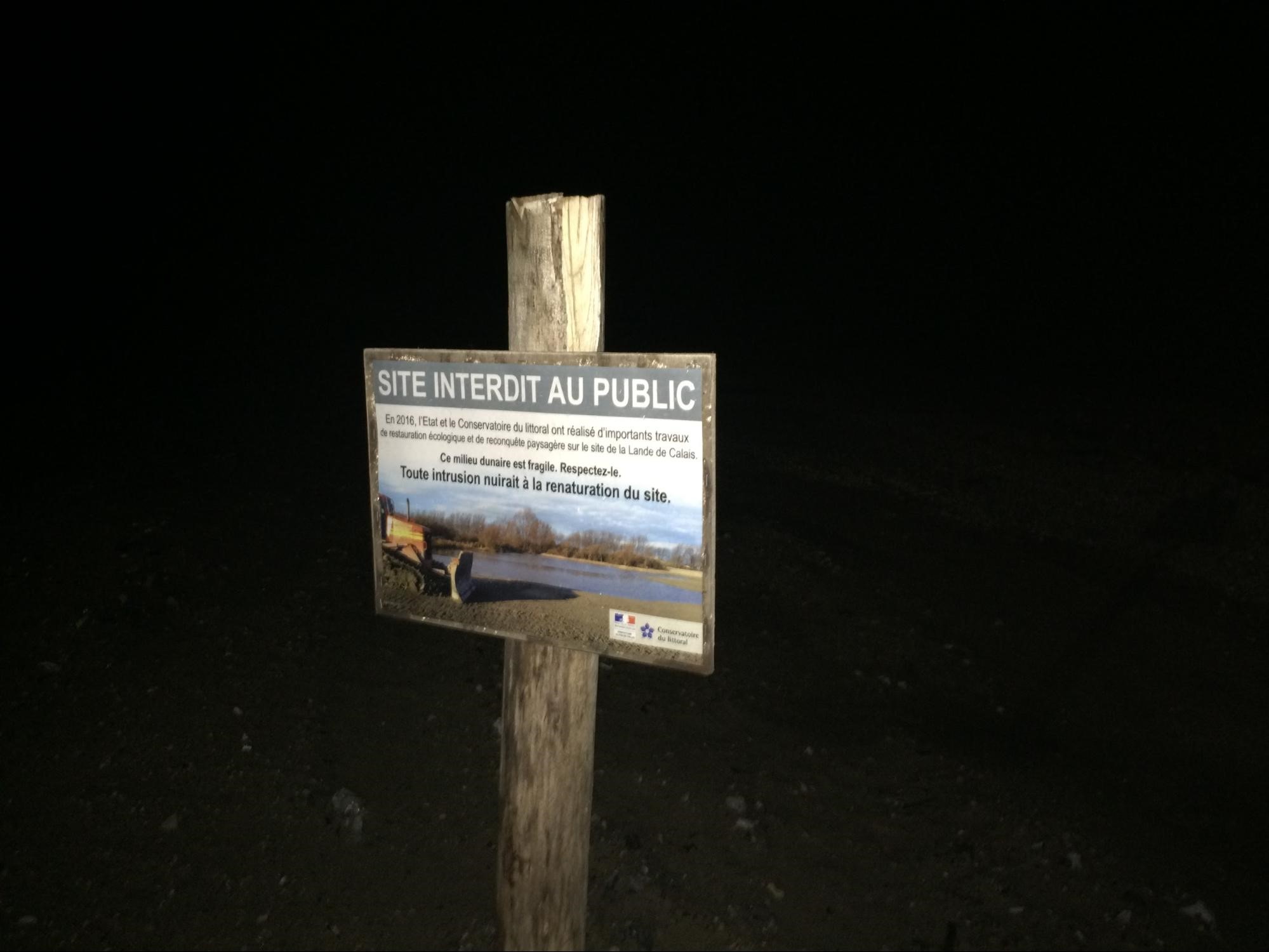
Sign preventing access in order not to disturb the process of ‘renaturing’ the site, February 2017, La Lande, Calais, France (courtesy of author).
Failed development and toxicity
Creation and destruction of ‘The Jungle’
- Natural defence
- Endangered species: a politics of rights
- Conservation and classification as political instrument
Introduction
In early March 2017, then-French Minister of Interior Bruno Le Roux spent a day in Calais, France, in the context of migration issues in the region. Part of his excursion involved a visit to La Lande, the site of migrant camp ‘The Jungle’, that was cleared of people and encampments in October 2016, and was now intended to become part of the neighbouring nature reserve Fort Vert. Accompanied by the Mayor of Calais, Natacha Bouchart, Le Roux was guided through the landscape by a representative of regional nature organisation Conservatoire du Littoral (Coastal Conservation). Interviewed on location by journalists, the minister stated:
“I wanted to be in Calais today with the elected officials and the mayor to see that the dismantling [of ‘The Jungle’] was a successful operation and that it will now continue with an ambitious project to return this territory back to nature. To ensure that it benefits the environment and especially to make sure that there will be no new encampments in Calais.”[1]
Le Roux’s explication of the site’s ‘return to nature’ as both beneficial to the environment as well as to security measures (‘to make sure that there will be no new encampments’) warrants an analysis of the nature reserve’s various features in the context of the UK and France’s history of border violence in and around Calais. The reserve’s objectives, laid out in a landscape proposal by Conservatoire du Littoral (see the image below), range from attracting migrating birds to cultivating the re-appearance of the highly protected fen orchid (Liparis loeselii), while at the same time constructing sandbanks, lakes and ditches to prevent access and thus new migrant encampments.
Following UK-France bilateral securitisation of Calais over the past 20 years, through walls, fences, forced evictions, surveillance, etc., a ‘return to nature’ of Calais’ biggest migrant camp to date raises urgent questions about the governmental motives related to the construction of ‘natural’ landscapes. To what historic nature is the landscape being ‘restored’? In what way does this constitute an erasure of more recent histories of border violence, migrant abandonment and expulsion? How do endangered species’ rights and protected habitat classifications act as a discriminatory regimen of exclusion and control of migrant presence? In what way does the implementation of a nature reserve play into ideas of ‘nature’ as ahistorical and uncontrolled, depoliticising an act of border enforcement?
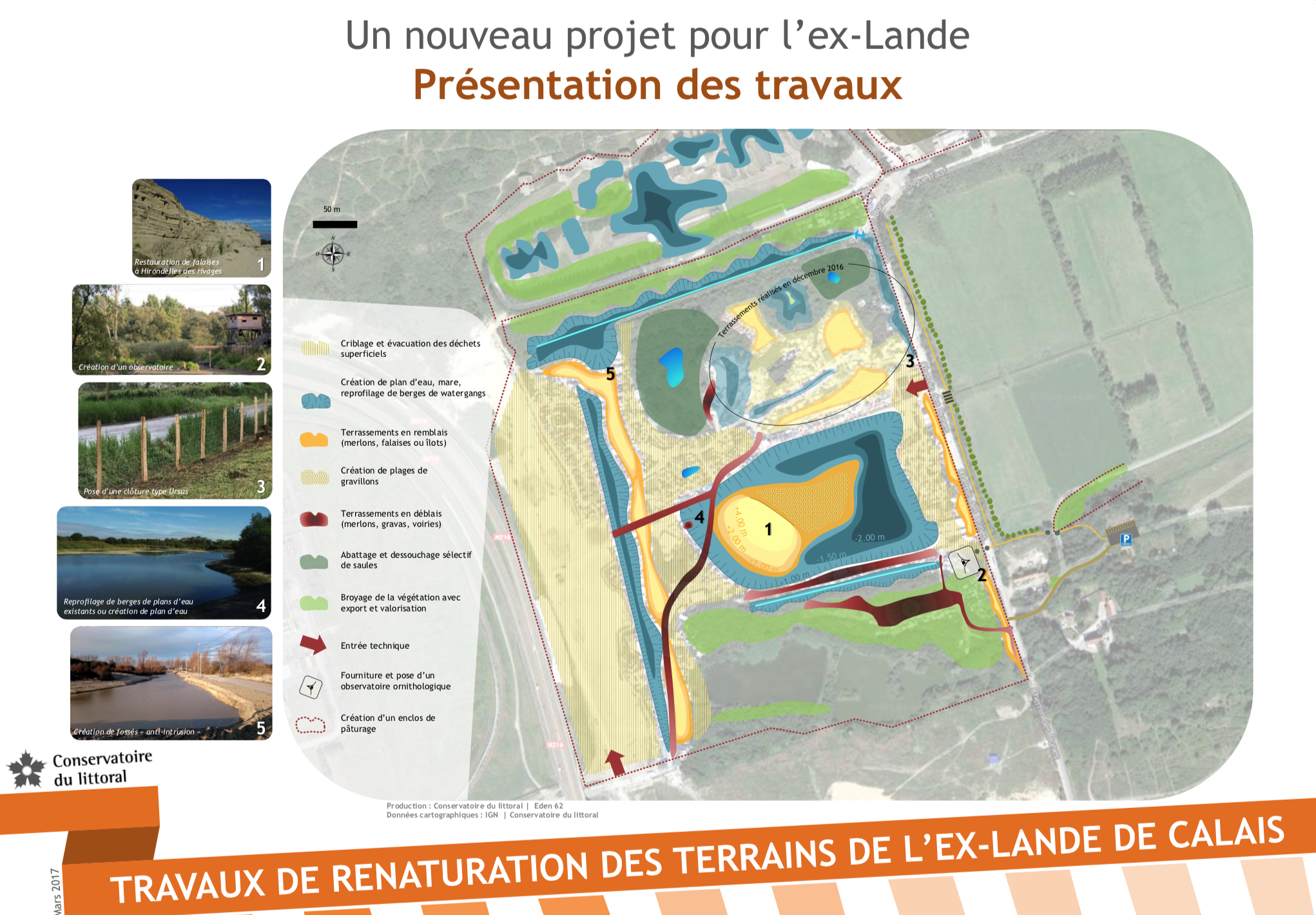
Proposed landscape design by Conservatoire du Littoral, with sandbanks and ditches marked as anti-intrusion methods, May 2017.
Fort Vert’s functioning as border regime is made evident by the involvement of the UK Border Force in its construction. Since the 2003 Touquet Treaty, which enabled both French and UK governments to exercise customs controls on either sides of the border, the UK has increasingly influenced and financed securitisation efforts in and around Calais, to which the Fort Vert nature reserve is no exception. The UK Border Force is clearly mentioned as a partner in the landscape design proposal by Conservatoire du Littoral (see the image below). The Home Office, however, in response to a 2017 freedom of information request, refused to release any details that would clarify the nature of this partnership. Even though the Home Office admits to possessing the information, they argue that it is exempt from disclosure as:
“This information could provide criminals and terrorists with an overview of the strengths and weaknesses of the security measures we have in place in Calais and the surrounding area. Renewed attempts could then be made to penetrate security measures based on dedicated expenditure information.”[2]
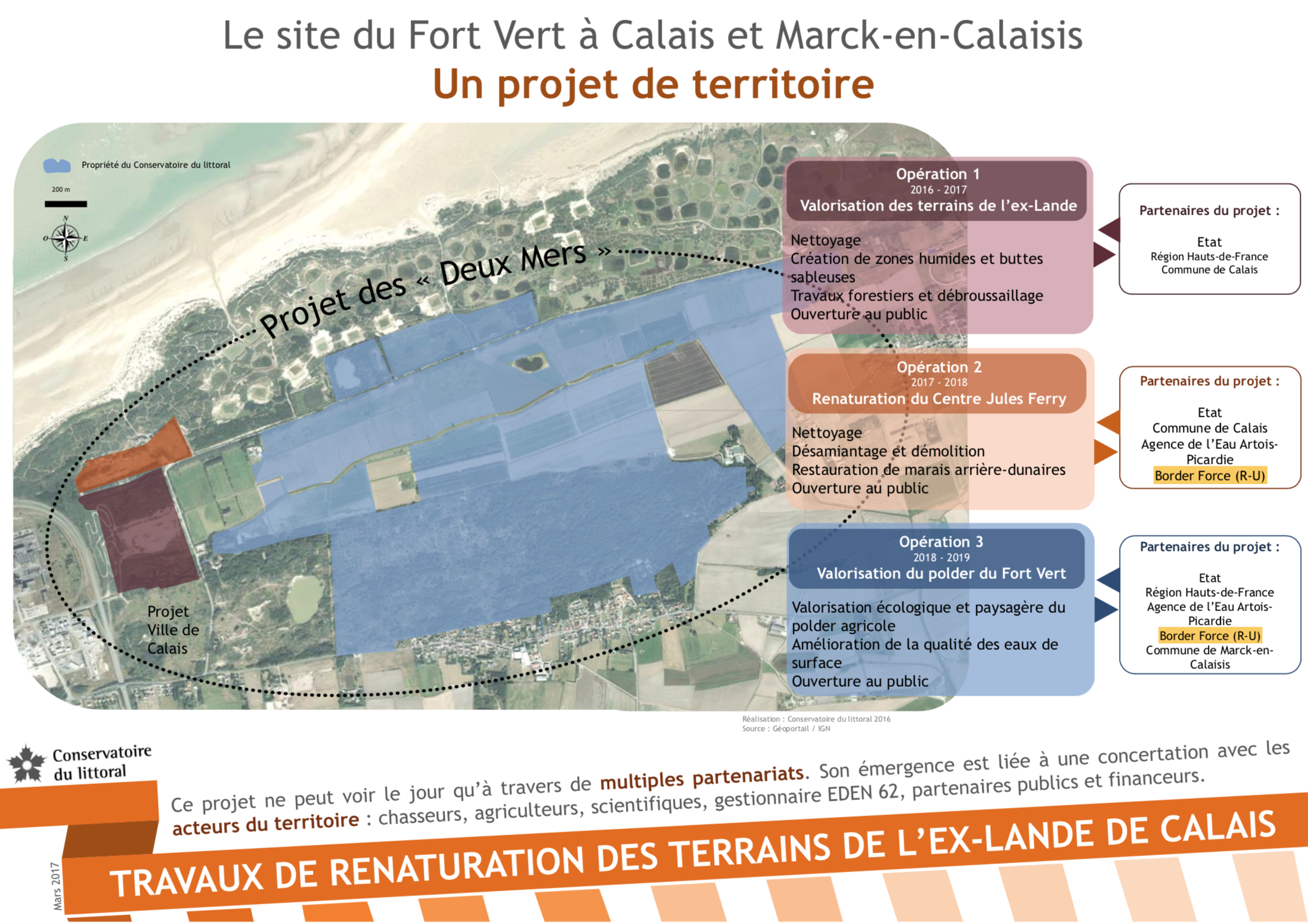
Landscape design proposal presented by Conservatoire du Littoral, with the UK Border Force’s partnership highlighted in yellow, May 2017.
Countering the narrative of a depoliticised ‘natural’ landscape, this article reveals the history of a site that went from agricultural land to envisioned industrial zone, to toxic waste dump, to migrant camp and now nature reserve, tracing the French and British joint efforts and discriminatory practices of controlling the border. Outlining the conditions that led to the creation of ‘The Jungle’ in a zone classified as toxic, its subsequent destruction and the security measures implicated in the process of ‘re-naturing’, this text aims to situate Fort Vert within a history of state violence and the extension of Theresa May’s ‘hostile environment’[3] into French territory.
Failed development and toxicity
During the late 1960s, due to expected population growth, the City Council of Calais conceived a plan that would enlarge the town’s industrial zone (Zone Industrielle Des Dunes) through the acquisition of what is now La Lande. The government procured the necessary land, but the anticipated economic expansion halted and the idea had to be abandoned in the 1970s. The plan was reinstated in 1987 in anticipation of the opening of the Channel Tunnel (which eventually happened in 1994) and the construction of several important roads (the A26 in 1988 and the N216 in 1991). However, Calais’ economy again faltered and the projected industrial extension never materialised. The infrastructural improvements that framed the authorities’ plans for the site strengthened the position of the Calais-Dover connection as the most popular crossing between the UK and the rest of Europe and generated an increase in formal and informal migration flows.
By this time the future Fort Vert was considered ‘greenfield land’ – continually awaiting development but never formally used. Whereas previous proprietors had cultivated the area, the government’s takeover meant activities on the land came to a halt and La Lande remained a wasteland for several decades. In fact, due to its proximity to two chemical factories (Interor and Synthexim) in 2012 the area was classified under the EU ‘Seveso III Directive’ as being subject to an increased risk of chemical accident hazard.[4] La Lande was also scattered with various types of potentially harmful waste, caused by years of illegal fly-tipping,[5] and the Jules Ferry centre – a former holiday camp just north of Fort Vert that has now been demolished – was built with asbestos. These toxic conditions accumulated to a significantly hazardous environment into which migrants, people willfully excluded from general standards of health and safety by European nation states, were readily pushed. As Thom Davies writes in his article Toxic Life (on the health and safety conditions of ‘The Jungle’):
“Framed as existential threats to the status-quo of the European political order – […] migrants become hazardous life; removed, encamped, numbered and regulated, set outside non-polluted spaces.”[6]
Creation and destruction of ‘The Jungle’
The authorities began forcing people into the area that would become known as ‘The Jungle’ in January 2015, when up to 2,000 people were inhabiting a number of camps throughout the town. Calais City Council opened a day centre in the former Jules Ferry holiday camp, bordering the northern half of La Lande, and French riot police (the CRS, Compagnies Républicaines de Sécurité) started moving people from their settlements towards the site, threatening forceful eviction if they failed to cooperate.
Under the premise of providing humanitarian aid (the centre would offer one hot meal a day, showers, drinking water, phone charging stations and beds for 40 women and children[7]) the state centralised the scattered migrant population in order to exercise a higher degree of control. For people inhabiting the new camp, it meant living further from the town centre (and thus from services such as those for processing asylum claims[8]) and a lack of protection from the elements (due to the landscape’s flat and open character). People also voiced concerns for health and safety, as the site bordered a hunting area, had no facilities for larger groups, lacked proper drainage and its loose sand was unsuitable for setting up camp.[9]
‘The Jungle’, at its peak, housed an estimated 7,300 people[10] from countries ranging from Syria, Afghanistan and Somalia to Iraq, Eritrea and Ethiopia. It became emblematic of the situation for displaced people in the EU. The miserable conditions on site meant the health of those living in the growing camp deteriorated over the course of 2015-16. Following a visit to the camp in October 2015, researchers from the University of Birmingham reported that migrants “routinely report hunger,” are exposed to “pathogenic bacteria, […] likely to be causing vomiting and diarrhoea,” and have limited access to usable toilets – the “resultant use of outdoor spaces for toileting presents further health hazards.” In addition, “extremely high levels of particulates associated with burning were found in the air within the camp and are a risk factor for respiratory infections, lung cancer and cardiovascular disease.”[11]
Throughout the camp’s existence (from January 2015 to October 2016) it was reorganised by authorities in various ways to increase mechanisms for control. For example, a 100-metre-wide strip between the camp and the highway was cleared of vegetation and encampments to facilitate surveillance. Placed in La Lande, on the periphery of Calais, out of sight and deprived of access to basic facilities, migrants were not only subject to strict management (often by force) by the state, they were equally exposed to a “violent political abandonment.”[12] At the same time, however, the site was also “a place of life and social stability... a thriving town with shops, restaurants, schools, and religious and community centres.” The dismantlement of the camp also meant the destruction of these communal social and political spaces, marking a new step in the “continued displacement” of its former residents,[13] and pointing to a circular process of concentration, abandonment and dispersal enforced by state actors.
“A return to nature”
1. Natural defence
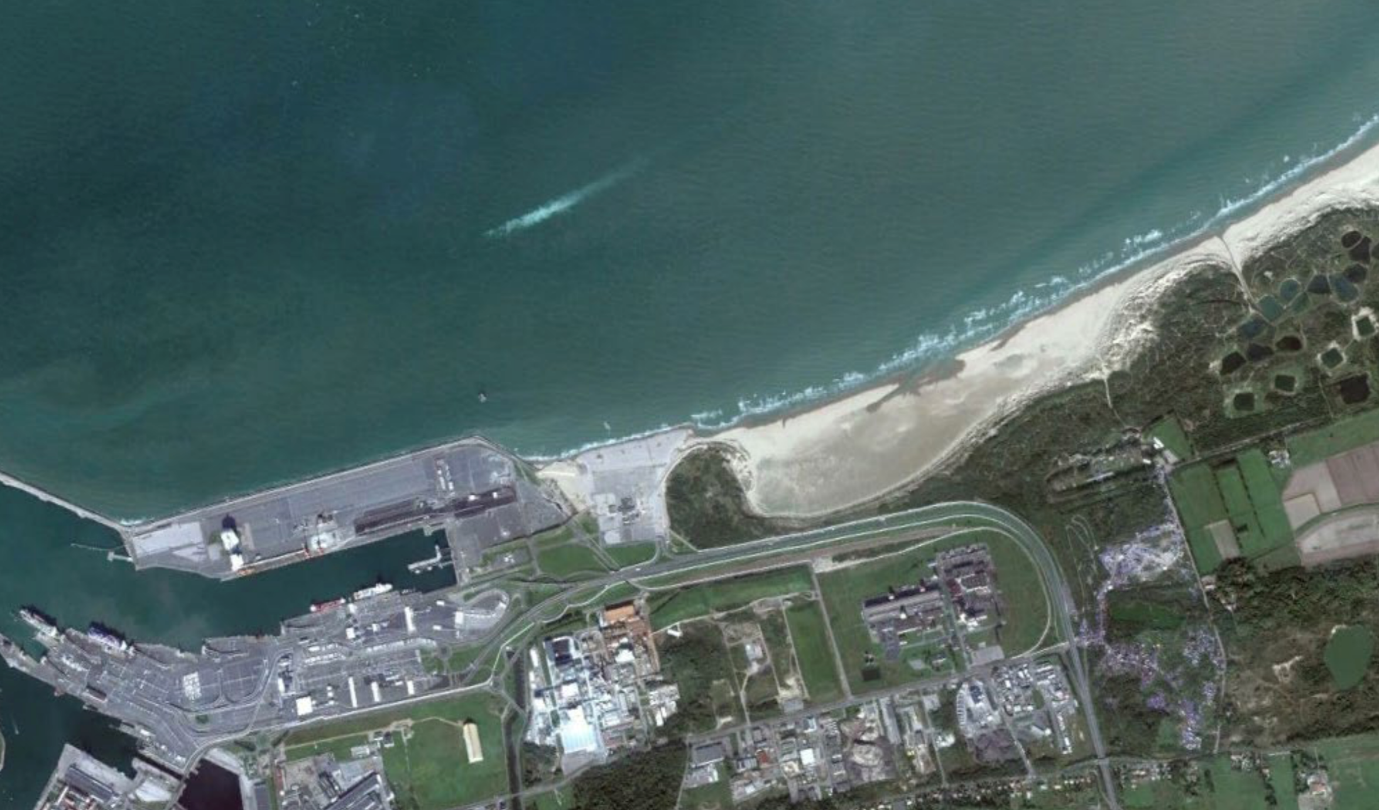
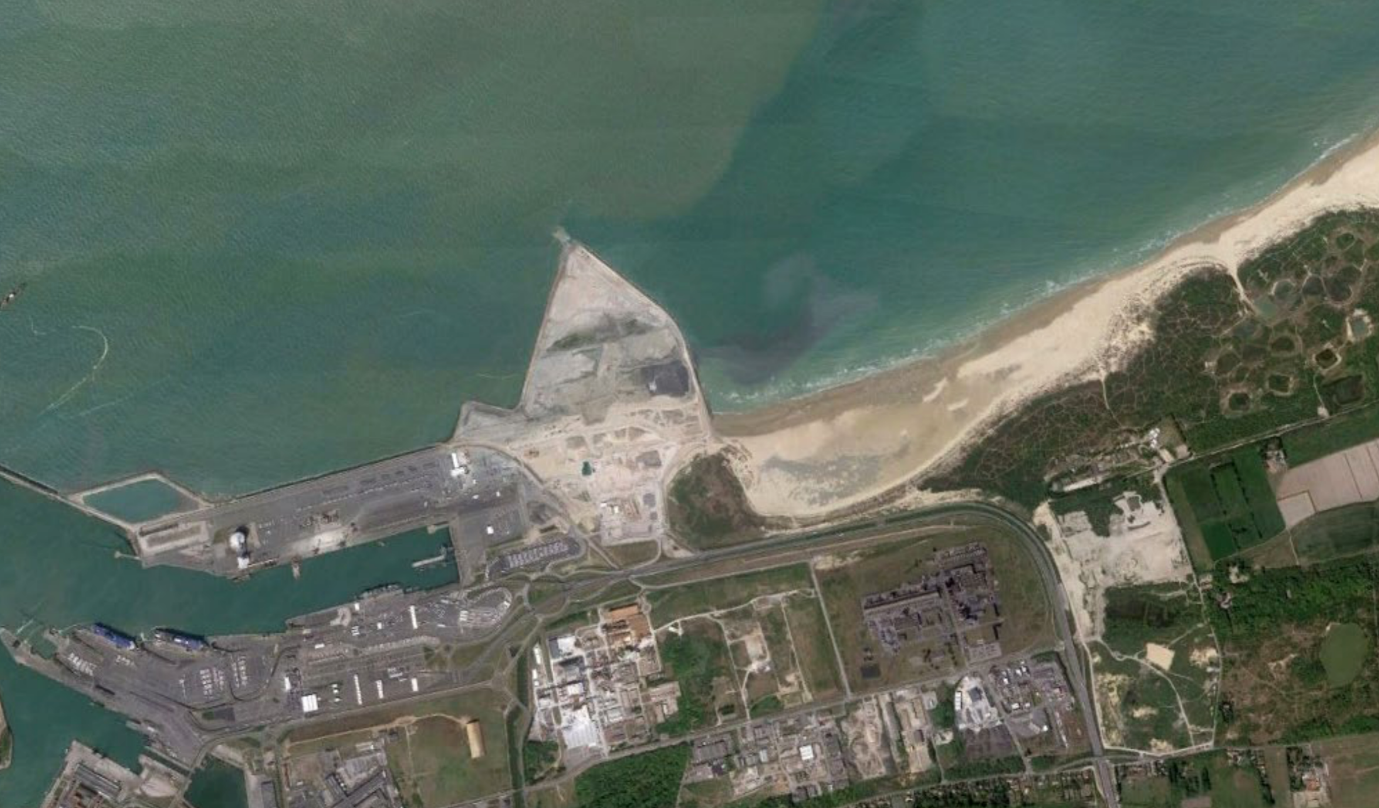
Construction of the port’s expansion through land reclamation, between 2015 and 2017, Google Earth
Even before the authorities started forcibly moving people to La Lande, the site was destined to become a nature reserve in 2012, as a compensatory measure for natural areas due to be destroyed by the expansion of the port (outlined in the plan ‘Calais Port 2015’[14]).
For this purpose, an organisation called Biotope performed a thorough ecological analysis of the plot, mapping observations of several (plant, insect, bird and animal) species and describing the habitats present at that time according to the European Habitat Directive. The state’s creation of ‘The Jungle’ interrupted this process and led to a number of adjustments to the original 2012 landscape design, mainly the addition of sandy barricades and ditches, dubbed as ‘anti-intrusion’ measures. [15] Functioning as means of ‘natural’ securitisation after the destruction of ‘The Jungle’, these sandbanks, in addition to fences and a moat, prevent access to the site and thus new settlement, as already put forth by Bruno Le Roux in March 2017. In addition, they make it impossible to see the interior of the space, as opposed to the complete visibility once inside (through the removal of higher vegetation and a levelling of the terrain), increasing the potential for surveillance.
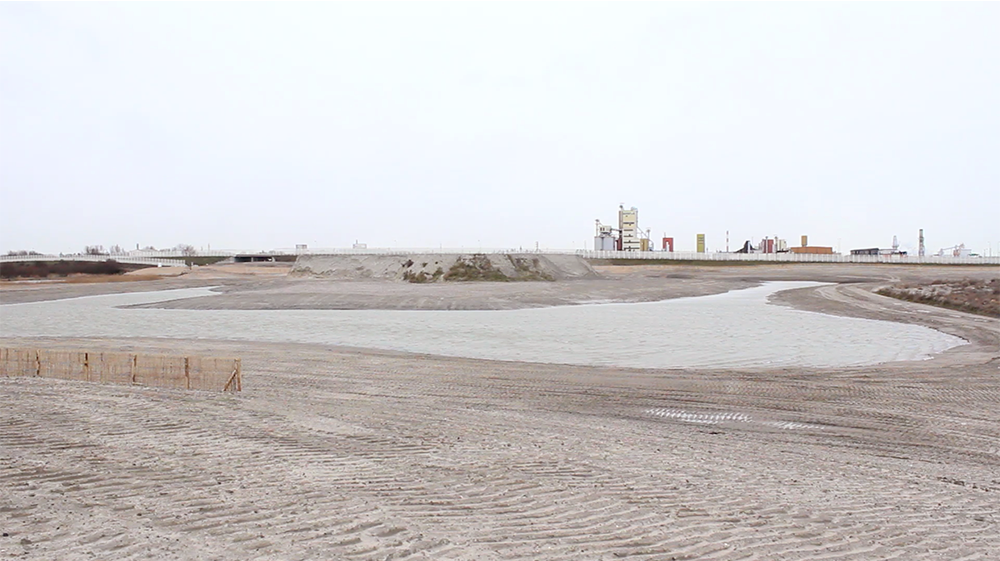
La Lande, Calais, France, February 2018.
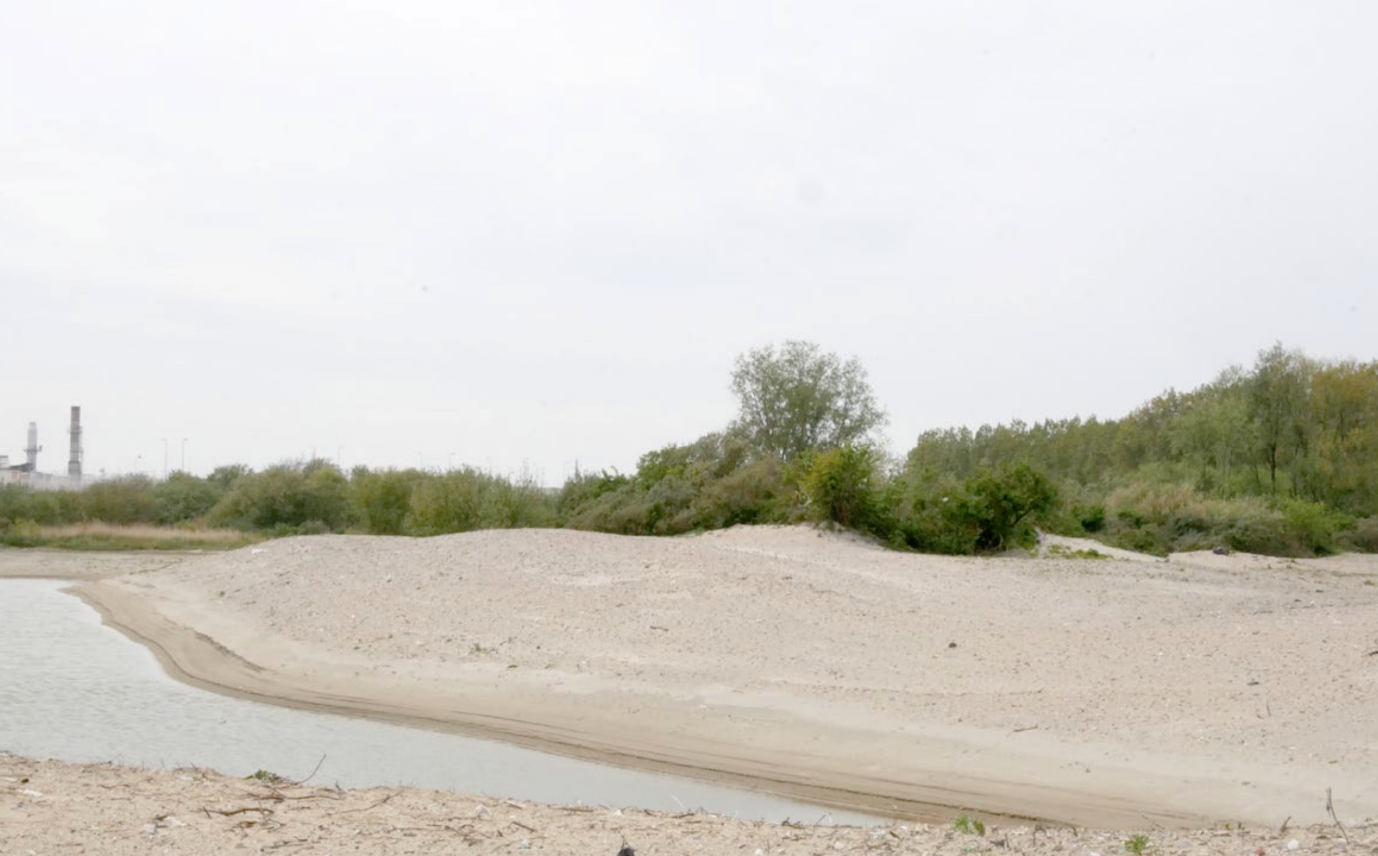
La Lande, Calais, France, May 2017.
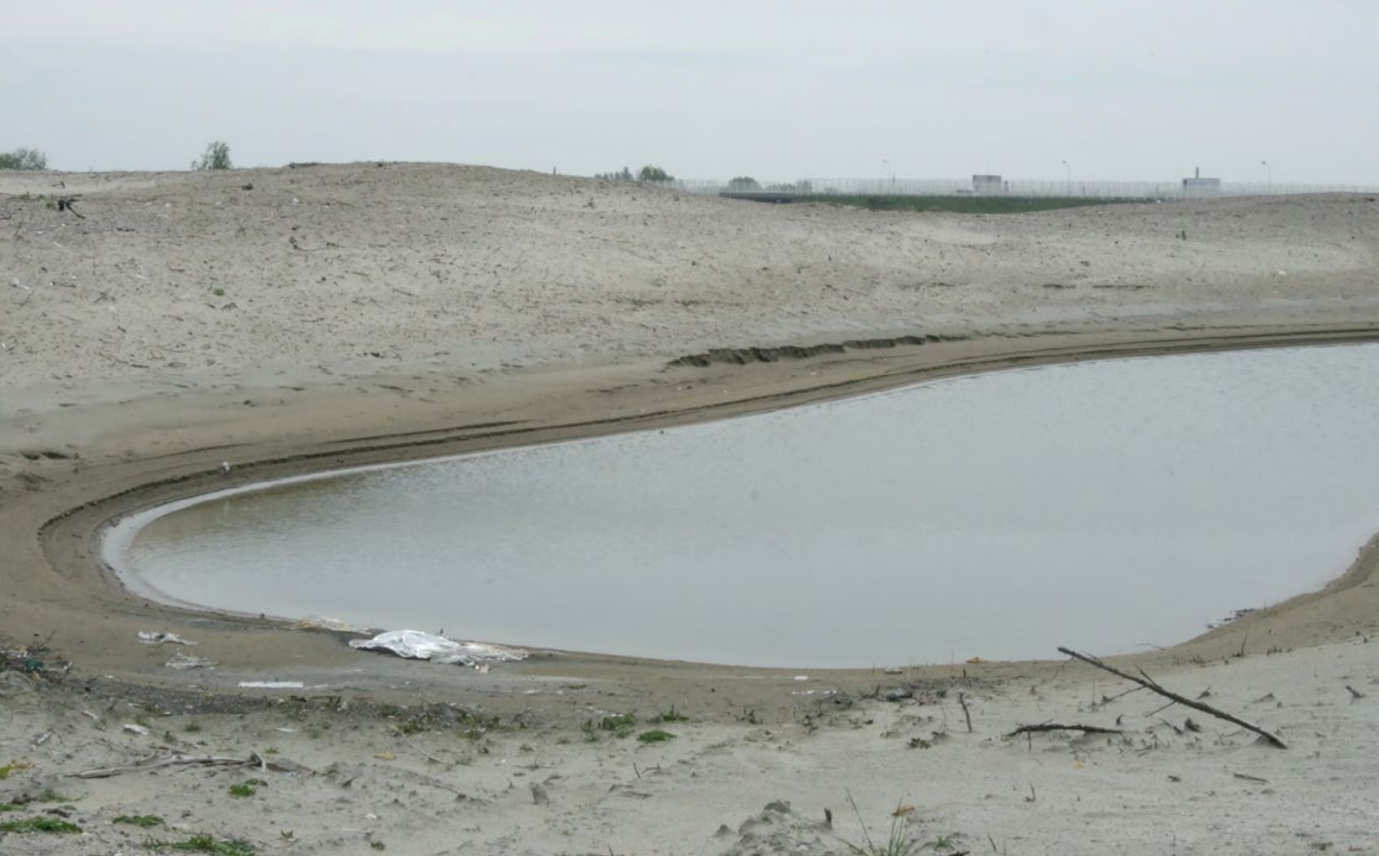
La Lande, Calais, France, May 2017.
2. Endangered species: a politics of rights
Although these structural adjustments were marked as security measures, they were also meant to serve the construction of specific EU classified habitats that would stimulate the re-appearance of the highly endangered fen orchid (known to have been present on the site some 15 years ago, based on observations from the late 1990s and 2003),[16] and the protection of biodiversity. A celebratory article in The Sun described the Fort Vert site as “spectacular” and noted how it had become “home to migrating birds, beautiful wildflowers and rare plants.”[17]
The fen orchid (Liparis loeselii), is a small yellow-leafed orchid native to Europe, Central Asia and North America, growing in a combination of dry sand dunes, grassland and marshes, where it prefers open, sunny places. It is about 25 cm high and can live for up to 8 years, coming into flower in early June. Due to grave declines in population, the fen orchid is classified as ‘endangered’ in the UK and ‘vulnerable’ in France. It can be found in several natural preservation areas throughout its geographical range and is often protected by national and European laws.[18]
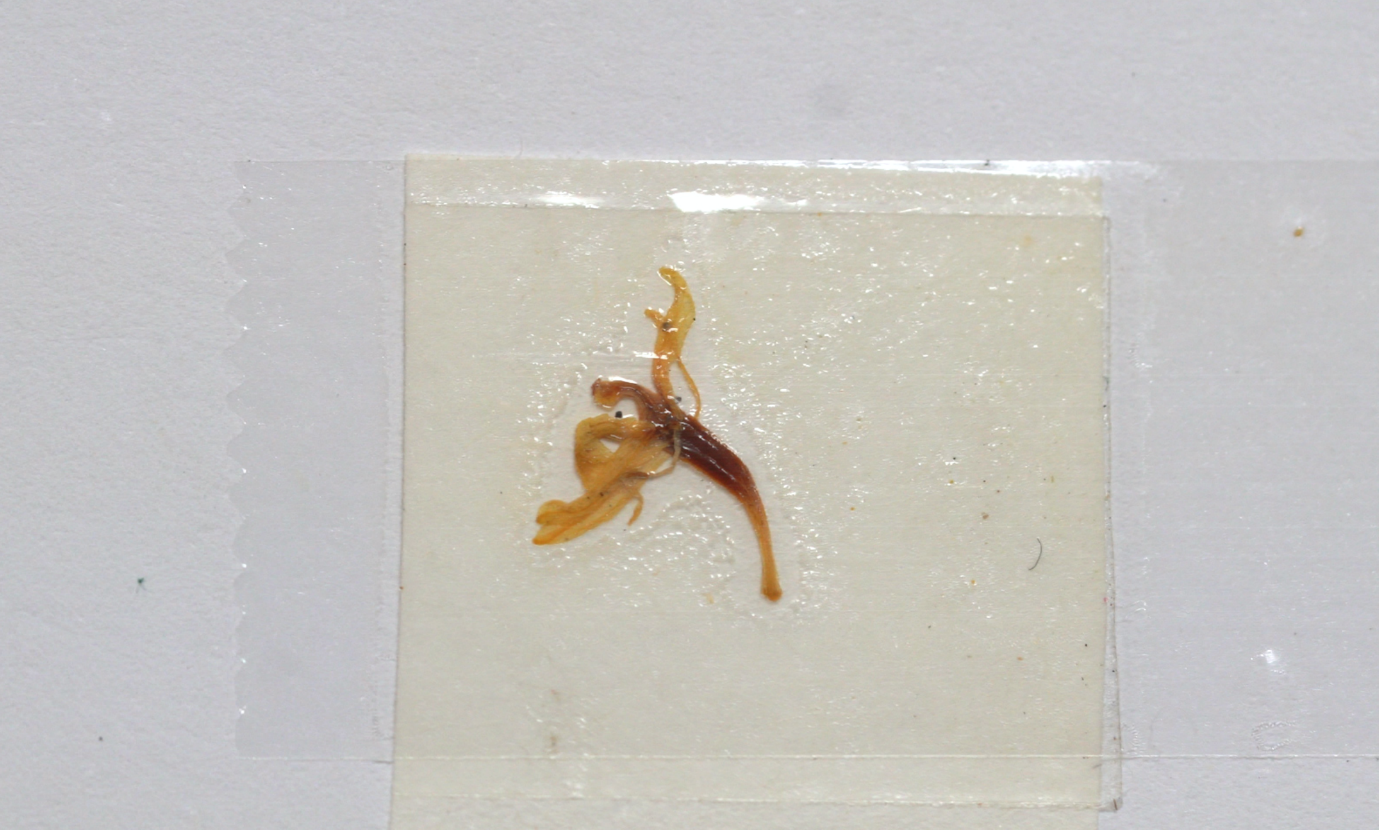
Specimen of a fen orchid (Liparis loeselii) at Conservatoire Botanique National de Bailleul, France, April 2019.
The projected reappearance of the fen orchid was one of the main objectives of the construction process that was framed as ‘renaturing’ – a concept that implies a number of assumptions of what it means for a landscape to be ‘natural’ and reveals a very particular process of picking and choosing what belongs in a place and what doesn’t. As the project’s former manager said in an interview in April 2019:
“I remember we went onto the site with a specialist of birds and a specialist of plants. One said, for the birds it would be perfect to have these plants, and the specialist of plants said, no, we want to find the Liparis loeselii. To restore an ecosystem is always a choice. What do you want on this place?”[19]
The restoration process involved, practically, the consultation of centuries-old maps to see what the landscape would have looked like, as well as the stripping of 20 centimetres of topsoil to lay bare dormant seeds of 60 to 70 years ago. A thorough cleaning of the soil also included the removal of invasive plants (spoken of as ‘waste’[20]) in order to make room for those plants considered to be ‘native’, such as the fen orchid.
The return and conservation of the endangered orchid presents a confrontation and negotiation of rights: those perceived as native, belonging ‘naturally’ to a place; and the human rights of people who are commonly seen as invaders, who do not belong and are pushed out. Rafi Youatt notes how species’ rights are usually addressed in a non-political way, through their ‘intrinsic value’: “this brushes aside the political qualities of rights, […] forged by social movements, individuals, and communities within existing social, political and legal contexts.”[21] In the space that is Fort Vert, where these rights coincide, thinking of the politics of rights as weaving across all species (‘interspecies politics’[22]), contributes to a more complete understanding of the environment as a political mechanism. It demonstrates that political, social and legal systems, as we perceive them to be forces that structure human life, extend to other species, and, more specifically, their rights can form the rejection of people’s, and vice versa. The environment must thus be understood as a technology in the formation and conservation of territory, shaping the border zone to be hostile to some, inviting to others.
3. Conservation and classification as political instrument
This understanding extends, importantly, to the making and implementation of environmental policies, endangered species plans, EU nature conservation networks (Natura 2000), scientific classification systems, etc., as these shape our ‘natural’ landscapes. For instance, Fort Vert, as the entire European landscape, is divided in certain coded habitats, typified according to the European Habitats Directive. These habitats are ranked according to their need of protection and form some of the legal grounds for the establishment of conservation areas. Habitat classification aims to construct a “coherent European ecological network of protected sites,”[23] by describing every habitat present in Europe, putting them in a legal context and mapping their scarcity as grounds for protection. This, however, as UK-based fen orchid specialist Tim Pankhurst pointed out to me,[24] suggests a confinement of species within a habitat that is artificial, assuming relations between species that may not exist, while excluding relations to other species that do. To put nature in a box – through demarcating and measuring – simultaneously assumes it has a boundary; an edge, when species actually behave in a more seamless and ambiguous fashion.
In case of the fen orchid for example, its close relation to human activity is absent from its policy context of ecological associations. The fen orchid’s growth is highly dependent on human and animal activity, as they don’t like to be overshadowed: movement by larger species clears out dense or higher surrounding vegetation. In fact, fen orchid populations only started declining some 150 years ago, as traditional human use of these specific habitats, such as peat digging and cutting fen for feeding cattle, became obsolete. In Fort Vert however, the complete remodelling of the site, seeking to create what could be seen as a clean slate for nature to then thrive on, is deemed necessary to erase and prevent unwanted human activity. Although reasoned to be beneficial for the presence of the species on the site, it counters what would be ecologically relevant to the fen orchid’s survival: an intersection of human and non-human activities. Thus, the process of selecting what is significant for environmental logic doesn’t shy away from the erasure of certain histories where deemed convenient. Recalling the words of the site’s former manager, “to restore an ecosystem is always a choice” – once nature is demarcated and written into law, it simultaneously becomes a legal and political instrument.
Conclusion
As we trace the landscape’s evolution from toxic greenfield to compensatory ground for destruction of natural heritage, to the concentration and subsequent eviction of migrants, to a protected site that houses endangered orchids, we distil various discriminatory mechanisms of border control and securitisation employed by France and the UK. The instrumentalisation of humanitarian aid to place people under surveillance in a zone of increased chemical hazard, the erasure of this history and the forceful expulsion of migrants through the reconfiguration of the landscape as a depoliticised natural reserve and the securitisation and continued displacement of certain people through ‘natural’ features under the premise of protecting biodiversity and endangered species. The Fort Vert nature reserve embodies this multiplicity of violences, formed through tactics of exclusion and hostility.
In addition, Fort Vert should not be seen as an isolated case: in recent years there has been substantial research on the weaponisation of the environment in the governing of borders in various places. Jason De Leon[25] and Juanita Sundberg,[26] for example, have examined the use of “prevention through deterrence” on the US-Mexico border, where migrants are funnelled into the desert’s most hostile terrains. Similar methods are employed in a European context, for example in the French-Italian Alps and the Mediterranean, as has been highlighted by Forensic Oceanography[27] and Riccardo Badano.[28]
The production of ‘environment’ cannot be seen separately from its political makers; in other words, as Rafi Youatt notes in his article Interspecies: “Environment is not just a neutral or passive term describing the environs of humans, but rather is an active practice involving a politics of encircling a particular area and naming it as an environmental site.”[29] As expulsion on the grounds of biodiversity protection or deterrence of migrants through natural terrain become active practices in the governing of borders, these should be accounted for in environmental discourse.
Hanna Rullmann
Footnotes
[1] Bruno Le Roux, ‘Le minister de l’intérieur ne laissera pas s’installer une nouvelle Jungle à
Calais’, Radio 6, 2 March 2017, http://www.radio6.fr/article-23385-le-ministre-de- interieur-ne-laissera-pas-installer-unenouvelle-jungle-a-calais.html
[2] ‘UK Border Force partner in Nature Reserve’, What Do They Know, www.whatdotheyknow.com/request/uk_border_force_partner_in_natur#incoming-1100063
[3] Amelia Hill, ‘’Hostile environment’: the hardline Home Office policy tearing families apart’, The Guardian, November 28, 2017, https://www.theguardian.com/uk-news/2017/nov/28/hostile-environment-the-hardline-home-office-policy-tearing-families-apart
[4] ‘Société des Usines Chimiques Interor (Calais) Synthexim (Calais)’, Prevention des risques, Hauts-De-France, 2012, https://www.hauts-de-france.developpement-durable.gouv.fr/?Societe-des-Usines-Chimiques-Interor-Calais-Synthexim-Calais
[5] Biotope Nord-Littoral, Calais Port 2015, Biotope, 2016, p.216
[6] Thom Davies, ‘Toxic life? The Slow Violence of refugee abandonment’, Toxic News, 4 November, 2015
[7] Ché Ramsden, ‘The new Sangatte: rights pushed out of sight’, OpenDemocracy, 13 April, 2015
[8] Ibid.
[9] Thom Davies, ‘Toxic life?’
[10] Elsa Buchanan, ‘Migrant crisis: A record 7,300 people now live in Calais' Jungle migrant camp’, International Business Times, 21 July 2016, https://www.ibtimes.co.uk/migrant-crisis-record-7300-people-now-live-calais-jungle-migrant-camp-1571819
[11] Surindar Dhesi, Arshad Isakjee, Thom Davies, ‘An Environmental Health Assessment of the New Migrant Camp in Calais’, University of Birmingham, 2015, p.2
[12] Thom Davies, ‘Toxic life?’
[13] Marta Welander, ‘Calais demolition: ‘mission accomplished’, the politics of exhaustion and continued struggles for mobility’, OpenDemocracy, 25 November 2016, https://www.opendemocracy.net/en/mediterranean-journeys-in-hope/calais-demolition-mission-accom/
[14] Biotope Nord-Littoral, Calais Port 2015, Biotope, 2016
[15] Conservatoire du littorale, presentation of landscape design: ‘Le site du Fort Vert à Calais et Marck-en-Calaisis’, March 2017, p.3
[16] Biotope Nord-Littoral, Calais Port 2015, Biotope, 2016, p.223.
[17] ‘Calais’ notorious ‘Jungle’ migrant camp is now a lush nature reserve after Britain-bound migrants were ordered to leave the crime-ravaged tent city’, The Sun, 12 September 2018, https://www.thesun.co.uk/news/worldnews/7241262/calais-jungle-migrant-camp-now-before-after-pictures/
[18] ‘Liparis loeselii’, Liparis loeselii (Fen Orchid), IUCN Red List, last modified 13 November 2017, http://www.iucnredlist.org/details/full/161960/1
[19] Ibid.
[20] Interview with Loïc Obled, (former) manager at Conservatoire du Littoral, April 2019, Paris, France.
[21] Rafi Yuatt, ‘Interspecies’ in Oxford Handbook of Environmental Political Theory, ed. Teena Gabrielson, Cheryl Hall, John M. Meyer and David Schlosberg, Oxford University Press, 2016, p.214
[22] Ibid., p.215
[23] ‘EC Habitats Directive,’ JNCC, published October 2014, http://jncc.defra.gov.uk/page-1374
[24] Interview with Tim Pankhurst, conservationist, conducted in July 2018, Norfolk, UK.
[25] Jason De León and Michael Wells, ‘The Land of Open Graves: Living and Dying on the Migrant Trail’, University of California Press, 2015
[26] Juanita Sundberg, ‘Diabolic Caminos in the Desert and Cat Fights on the Río: A Posthumanist Political Ecology of Boundary Enforcement in the United States–Mexico Borderlands’, Annals of the Association of American Geographers, 101, no. 2, 16 March 2011, pp.318–36.
[27] Charles Heller and Lorenzo Pezzani. ‘Ebbing and Flowing: The EU’s Shifting Practices of (Non-) Assistance and Bordering in a Time of Crisis’, http://nearfuturesonline.org/ebbing-and-flowing-the-eus-shifting-practices-of-non-assistance-and-bordering-in-a-time-of-crisis/
[28] Riccardo Badano, ‘Hostile Environment: the design of anti-migrant hostility along the Western Alpine Arc’, MA thesis, Goldsmiths University of London, October 2018
[29] Rafi Yuatt, ‘Interspecies’ in Oxford Handbook of Environmental Political Theory, ed. Teena Gabrielson, Cheryl Hall, John M. Meyer and David Schlosberg, Oxford University Press, 2016, p.212
Our work is only possible with your support.
Become a Friend of Statewatch from as little as £1/€1 per month.
Spotted an error? If you've spotted a problem with this page, just click once to let us know.